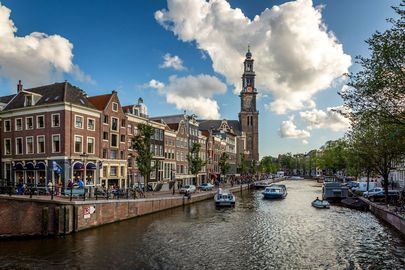

The Westerkerk was built between 1620 and 1631 after a design by Hendrick de Keyser, the city's chief architect at the time. The Westerkerk was built in the form of a patriarchal cross in Dutch Renaissance style. It measures 48 meters in length, 28 meters in width and is 27.5 meters high up to the wooden barrel vaulting in the nave. Daylight pours in from all sides through the 36 large glass-plated windows. The light is not obstructed by any adjacent constructions and is further enhanced by the whitewashed walls of the church’s grand interior.
Pillars, arcs, joists, pilasters and the main frame of the lower floor are made of Bentheim sandstone painted dark grey. Since the Westerkerk was commissioned by the then Amsterdam City Council, the city's coat-of-arms - the Imperial crown and the three St. Andrew's crosses - is a recurring theme both inside and on the exterior this magnificent church. The crown is that of Maximilian of Austria, who supported the cities bourgeoisie in their fight against countryside aristocracy. In the 1400-1500s Amsterdam loaned Maximilian a lot of money and in exchange was allowed to have the Imperial crow in its coat-of-arms. The three St. Andrew's crosses are said to be spells against fires, floods and the Black Plague, however there's no historical basis for this legend. The nave and the two high aisle bays are covered by wooden barrel vaults that form groined vaults at the crossbeams. The low aisle bays have cross-ribbed stone vaults. The Westertoren - the Westerkerk's soaring 85 meter tower - was built in 1638 and has often been the subject of many of the Jordaan’s ‘levenslieden’. It is also mentioned in Anne Frank's diary, as the steeple was visible from the Frank's hiding place. Until 2006, the crown had a golden tint, however during restoration works in 2006-07, it was endowed with a more appropriate historically color scheme. Now the crown is a striking ultramarine blue.
In 1578, Amsterdam joined the Prince of Orange cause to oust Roman Catholic regents out of the Netherlands. As a result of the so-called Alteration, seven of Amsterdam's Roman Catholic churches fell into the hands of the Dutch Reformed Church. After the Alteration, in just one century, Amsterdam's population grew dramatically from 30,000 to 200,000. Many newcomers migrated from rural regions, but most of the influx were refugees from France, Germany and Belgium escaping prosecution from the catholics. The suburban Jordaan was built to accommodate the growing number of new city residents. While the low Noorderkerk was built as the congregation for the Jordaan's lower classes, at the other end of the Prinsengracht, the Westerkerk soared high for the wealthy Canal Ring residents.
Until mid-19th century the Westerkerk served as a burial place for many of Amsterdam's notorieties. Rembrandt, who lived out his latter days in the neighborhood, was buried in this church. Since he died in poverty and could not afford a private grave, his remains were buried in a common grave. Therefore the exact location of his grave is unknown.
De Westermarkt, the square surrounding the Westerkerk, features several monuments. In front of the sexton's house stands the statue of Anne Frank, frequently photographed by the passersby. The so-called Homo Monument faces the Keizersgracht at the back of the Westerkerk. It commemorates all gay men and lesbians who have been subjected to persecution because of their homosexuality. It was opened on September 5, 1987 and is made up of three large granite triangles, set into the pavement to form a larger one. The Homo Monument is meant to inspire and support lesbians and gays in their struggle against denial, oppression and discrimination, as wells as commemorates the gays and the lesbians who were murdered by the Nazis. It was the first monument of its kind worldwide.